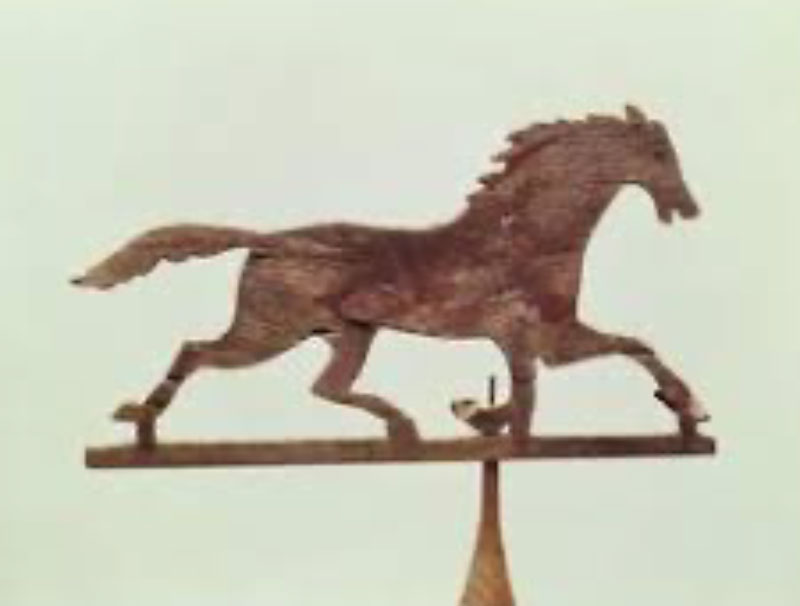The Art of the Winds: Weathervanes at the American Folk Art Museum
Sharon Lorenzo intrigues us with early American weathervanes.

This marvelous exhibition of historic weathervanes traces the evolution of an art form that began as a utilitarian object in ancient China and Greece during the 2nd Century BCE. On the agora market building in Athens, a bronze mermaid holding a rod was designed to show the direction of the wind. The oldest surviving vane is in Lombardy, Italy of a rooster which Pope Gregory said was a suitable emblem of Christianity referencing St. Peter whom Jesus said would betray him three times before the rooster crowed. One theory was that the roosters on the churches were emblems of the vigilance of the clergy calling the people to prayer.[1]

Weathercock, c. 1772. Museum of Fine Arts, Boston. Copper, iron, lead.
Authorities think that the name weathervane came from an old German word fano meaning flag or banner. As the early colonists settled in the Americas, they brought the weathervane along as an adornment to public buildings such as the golden grasshopper which was placed on the top of Faneuil Hall in Boston as a symbol of American patriotism.

Eagle and Shield, @1800 Canton, Mass. Bronze and copper.
After winning independence in 1776, the weathervanes embraced the new republic with images of the eagle and American shield such as this one which may have been cast by Paul Revere himself from his studio in Canton, Massachusetts.[2]

Dove of Peace, Mt. Vernon, Virginia, 1787. Copper, iron and lead with gilt.
George Washington commissioned a dove of peace weathervane for his home, Mt. Vernon, in Virginia where a replica of the original still flies today. Fabricated in Philadelphia, Washington requested that an olive branch should be placed in the mouth of the bird as a symbol of peace.

Horse attributed to A. L. Jewell, Waltham , Mass. @1860. Molded copper and zinc.
American craftsmen before and during the Civil War years working as carpenters and metalsmiths began to experiment with the mixing of materials to better retain paint or gilt during storms of rain, sleet and ice. By 1860, A. L. Jewell had an entire business in Waltham, Massachusetts devoted to their manufacture as he began to cast more creative ideas such as this horse made of molded copper with zinc for the head and tail.

Gabriel Weather Vane, Universalist Church, Newburyport, Mass. @1840, gold leaf on iron and copper.
One of my favorites from this era was the image of the archangel Gabriel announcing the coming of Jesus from the gospel of Luke in the Bible to the Virgin Mary.
Folk art expert, Robert Shaw, was hired to write a very informative and thorough catalog of this exhibition which traces the historical evolution of the weathervane from its early functional uses to the passion of private collectors today. Many lenders to this show were proud to share their pieces such as this Goddess of Liberty from Michael and Patricia Del Castello.[3]

Goddess of Liberty, Cushing and White Co., Waltham, Mass. @ 1868-70. Copper and zinc with paint and gilt.

Massasoit, @1880. Molded copper, collection of Jane and Gerald Katcher. Harris and Snow Companies, Boston, Mass.
Two companies in Boston merged to form the J. Harris and W.A. Snow partnership about 1880 for the manufacture of complex weathervanes in demand in the 19th century such as this one depicting the sachem of the Wampanoag tribe, Massasoit, who greeted the Pilgrims upon their arrival in Plymouth, Massachusetts in 1620. Written reports stated that he saved the early settlers from starvation during their first difficult winter. This vane appears to have been cast from a mold which managed to capture the details of his bow and arrow as well as his three- leafed crown.[4]

Touring car and driver, Snow Iron Works, Mass.,1910. Molded iron and copper.
Robert Shaw served as curator for the Shelburne Museum from 1981-1994 which indeed has its own collection of American folk art in Shelburne, Vermont. His thorough study and revelation of the history of this utilitarian object made into a form of collectible folk art is indeed worthy of a close read and a lengthy visit to the American Folk Art Museum before the end of 2021.
The Art of the Winds: Weathervanes at the American Folk Art Museum
2 Lincoln Square, New York, NY 10023
June 23, 2021-January 2, 2022
[1] Forster, Thomas. Circle of the Seasons, 1828, p. 18.
[2] Shaw, Robert. American Weathervanes, The Art of the Wind. American Folk Art Museum, 2021. P. 25.
[3] Ibid, p 152.
[4] Ibid, p. 169.
The post The Art of the Winds: Weathervanes at the American Folk Art Museum appeared first on Sharp Eye.